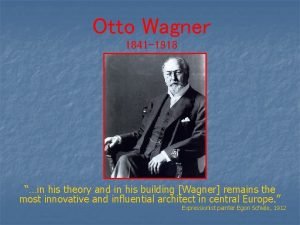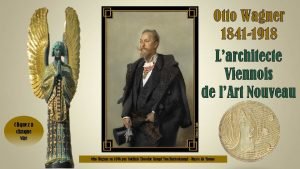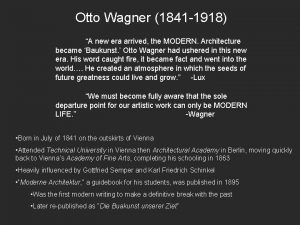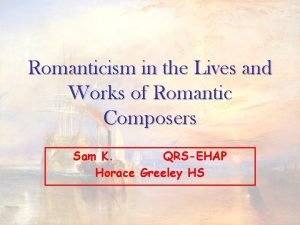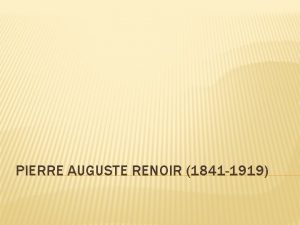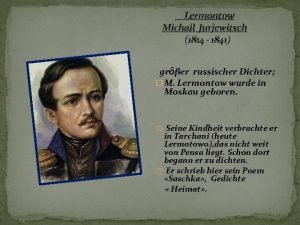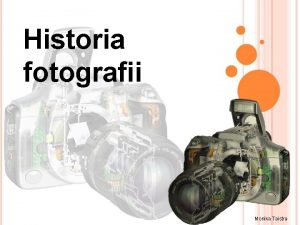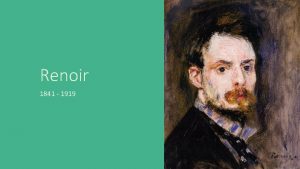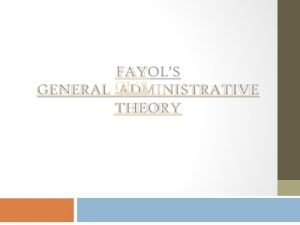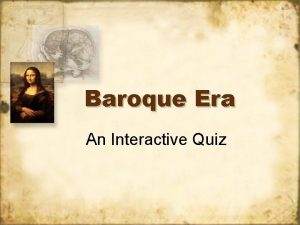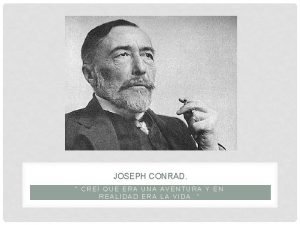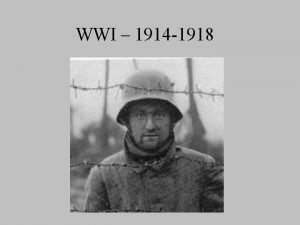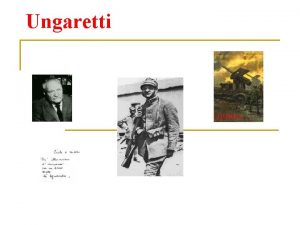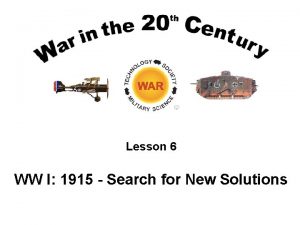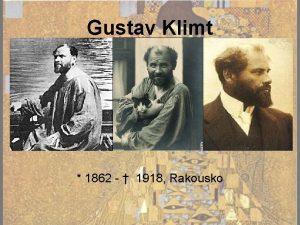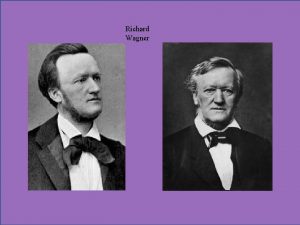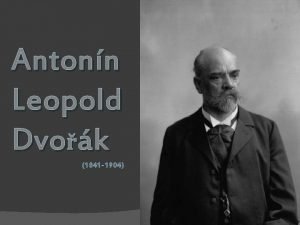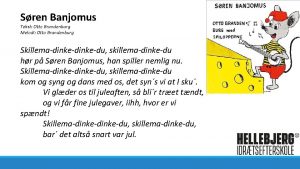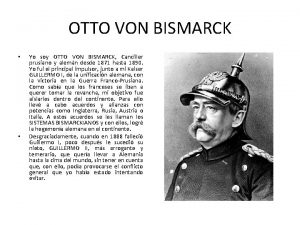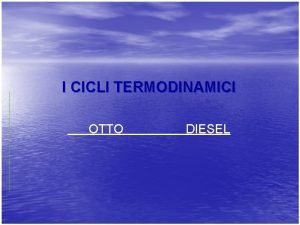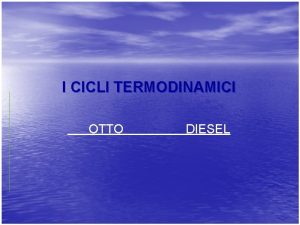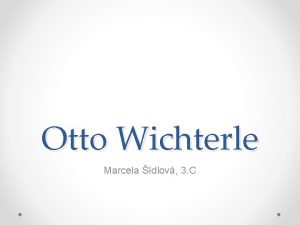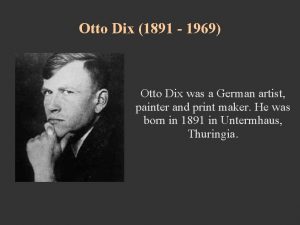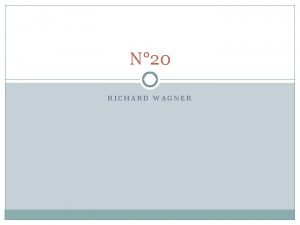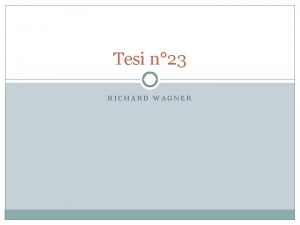Otto Wagner 1841 1918 A new era arrived


























- Slides: 26

Otto Wagner (1841 -1918) “A new era arrived, the MODERN. Architecture became ‘Baukunst. ’ Otto Wagner had ushered in this new era. His word caught fire, it became fact and went into the world…. He created an atmosphere in which the seeds of future greatness could live and grow. ” -Lux “We must become fully aware that the sole departure point for our artistic work can only be MODERN LIFE. ” -Wagner • Born in July of 1841 on the outskirts of Vienna • Attended Technical University in Vienna then Architectural Academy in Berlin, moving quickly back to Vienna’s Academy of Fine Arts, completing his schooling in 1863 • Heavily influenced by Gottfried Semper and Karl Friedrich Schinkel • “Moderne Architektur, ” a guidebook for his students, was published in 1895 • Was the first modern writing to make a definitive break with the past • Later re-published as “Die Buakunst unserer Ziet”

Moderne Architektur • Otto Wagner wrote Modern Architecture to create a new STYLE • Three principle themes of Modernism: • A plea for simplicity in the accommodation of modern needs • The artistic and ethical ruin of eclecticism • The demand for a new style based on present technologies and methods of construction

Table of Contents • Chapter 1: The Architect • Chapter 2: Style • Chapter 3: Composition • Chapter 4: Construction • Chapter 5: The Practice of Art • Chapter 6: Concluding Remark “Almost everywhere the MODERN movement has marched in victorious. Its opponents thronged into camp as deserters; the opposition’s best warriors faltered when they saw that the shield of eclecticism and ‘intimacy’ that they were holding up to the onslaught of the MODERN movement was only made of pasteboard. ” -Wagner

The Architect “Among the fine arts architecture alone is truly creative and productive; in fact, it alone is able to make forms that have no model in nature yet appear beautiful to man. ” -Wagner • The education of the architect: • Technically trained, 22 to 26 years of age, imagination, taste, keen thinking • Qualifications for a professional: • Must have the ability to perceive needs • The title “Architect” • Misused by those who have no claim to it


Style “The artist has been content to dissect the dead with a magnifying glass and lancet, instead of listening to the pulse of those who are alive and relieving their pains. ” -Wagner • The modern style is a response to the needs of modern man • He argues that the logical consequence of catering to these needs is that art, and artist, are then forced to represent their epoch and to conform to modern appearances and ideas, even to the point of staying in step with fashion. • Architecture’s basis was no longer to be symbolic form, but construction and technology. • Not only a building style; modernism affected all aspects of the aesthetics.





Composition “The ‘modern eye’ has lost it’s sense for a small and intimate scale and become accustomed to less varied images, to longer straight lines, to more expansive surfaces, and to plainer silhouetting. ” -Mallgrave • Emphasizes the human need for a visual resting point; otherwise a painful uncertainty or aesthetic uneasiness occurs. • The image to be perceived, whether from single or multiple viewing points, was very important to Wagner. • Viewing points: locations where the building can be seen most frequently, most easily and most naturally • Wagner stressed a need for symmetry, as it provided self-containment, completeness and balance





Construction “The role of the architect is to acknowledge new technical means arising from needs and interpret them in a way suited to modern sensibility. ” -Mallgrave • Wagner felt there was a break with the past because of the changes in modern construction methods; new technical and material means needed new formal solutions • Need, purpose, material and construction are conveyed as the primitive “germs” of architectural production • Therefore, new purposes and materials lead to new methods of construction • Construction gradually acquires artistic value, leading to art-forms • The introduction of IRON was the main reason for this change of vision






The Practice of Art “There are two conditions demanded by modern man that can be considered to be criteria: the greatest possible convenience and the greatest possible cleanliness. ” -Wagner The Practice of Art, according to Wagner, Includes: • Representation through drawing • City Planning: Streets, Squares, Urban Gardens, Fountains, Bridges • Railroads • Dwellings • Art in Industry and Production: Furniture, Illumination, Decoration, Clothing/ Fashion, Materials




Bibliography Geretsegger, Heinz. Otto Wagner 1841 -1918 : the expanding city, the beginning of modern architecture / by Heinz Geretsegger and Max Peintner ; associate author Walter Pichler ; introd. by Richard Neutra ; translated by Gerald Onn. New York : Rizzoli, 1979. Kruft, Hanno-Walter. A history of architectural theory : from Vitruvius to the present/ Hanno -Walter Kruft ; translated by Ronald Taylor, Elsie Callander, and Antony Wood. London : Zwemmer ; New York : Princeton Architectural Press, c 1994. Wagner, Otto, 1841 -1918. Modern architecture : a guidebook for his students to this field of art / Otto Wagner ; introduction and translation by Harry Francis Mallgrave. Santa Monica, Calif. : Getty Center for the History of Art and the Humanities, 1988.
 Otto wagner works
Otto wagner works Otto wagner louise stiffel
Otto wagner louise stiffel Otto wagner moderne architektur
Otto wagner moderne architektur Wagner romantic era
Wagner romantic era History of sarswela in the philippines
History of sarswela in the philippines Router 1841 cisco packet tracer
Router 1841 cisco packet tracer Henri fayol (1841-1925)
Henri fayol (1841-1925) Nabucodonsor (1841)
Nabucodonsor (1841) Pierre auguste renoir biographie
Pierre auguste renoir biographie Russischer schriftsteller 1814 bis 1841
Russischer schriftsteller 1814 bis 1841 Monika 1841
Monika 1841 Consejo superior de salubridad 1841
Consejo superior de salubridad 1841 Impressionist 1841-1919
Impressionist 1841-1919 Scalar chain clipart
Scalar chain clipart Era quiz: the baroque era
Era quiz: the baroque era Elizabethan era vs victorian era
Elizabethan era vs victorian era Creí que era una aventura y en realidad era la vida
Creí que era una aventura y en realidad era la vida Vi uma estrela tão alta
Vi uma estrela tão alta Map of europe 1914
Map of europe 1914 Rzeczpospolita trojga narodów
Rzeczpospolita trojga narodów Bosco di courton dove si trova
Bosco di courton dove si trova Varför kallas perioden 1918-1939 för mellankrigstiden
Varför kallas perioden 1918-1939 för mellankrigstiden Ft17
Ft17 1918-1862
1918-1862 Jim crow (character)
Jim crow (character) 18 novembris 1918
18 novembris 1918 What is the red scare
What is the red scare
